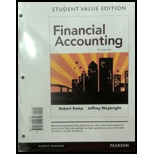
Concept explainers
The order in which assets were listed and described in the text is the order in which you will see them listed on the
Explain the organizing principle behind the listing of assets on the balance sheet.
Explanation of Solution
Asset:
Assets refer to the resources owned by the business, which are utilized in the course of the business to generate revenue.
The organizing principle behind in the listing of assets on the balance sheet as follows:
At the time of listing of assets on the balance sheet, the assets are prioritized based on the liquidity. The high liquid assets are reported in the beginning of asset section, and then low liquid assets are reported.
Want to see more full solutions like this?
Chapter 2 Solutions
Financial Accounting, Student Value Edition (4th Edition)
- KD Industries has 30 million shares outstanding with a market price of $20 per share and no debt. KD has had consistently stable earnings and pays a 35% tax rate. Management plans to borrow $200 million on a permanent basis through a leveraged recapitalization in which they would use the borrowed funds to repurchase outstanding shares. The present value of KD's interest tax shield is closest to a. $130 million b. $200 million c. $400 million d. $70 millionarrow_forwardCorrect answer please general accountingarrow_forwardTargeted pre tax income?arrow_forward
- Please provide the correct answer to this financial accounting problem using accurate calculations.arrow_forwardIf a country can give up one unit of future consumption and as result increase its current consumption by 0.94 units, its real rate of interest must be: (a) 1.4% (b) 3.4% (c) 6.4% (d) 9.4%arrow_forwardWhat is the total contribution margin??arrow_forward
 College Accounting (Book Only): A Career ApproachAccountingISBN:9781337280570Author:Scott, Cathy J.Publisher:South-Western College Pub
College Accounting (Book Only): A Career ApproachAccountingISBN:9781337280570Author:Scott, Cathy J.Publisher:South-Western College Pub Cornerstones of Financial AccountingAccountingISBN:9781337690881Author:Jay Rich, Jeff JonesPublisher:Cengage Learning
Cornerstones of Financial AccountingAccountingISBN:9781337690881Author:Jay Rich, Jeff JonesPublisher:Cengage Learning College Accounting, Chapters 1-27AccountingISBN:9781337794756Author:HEINTZ, James A.Publisher:Cengage Learning,
College Accounting, Chapters 1-27AccountingISBN:9781337794756Author:HEINTZ, James A.Publisher:Cengage Learning,



